check engine MITSUBISHI OUTLANDER PHEV 2017 (in English) Owner's Guide
[x] Cancel search | Manufacturer: MITSUBISHI, Model Year: 2017, Model line: OUTLANDER PHEV, Model: MITSUBISHI OUTLANDER PHEV 2017Pages: 548, PDF Size: 25.5 MB
Page 457 of 548
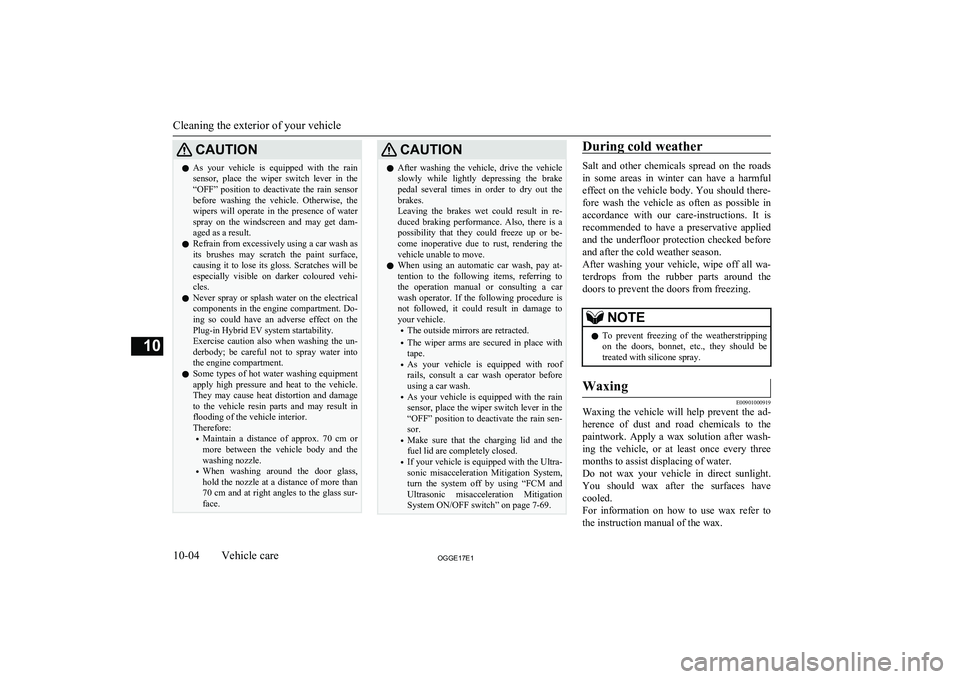
CAUTIONlAs your vehicle is equipped with the rain
sensor, place the wiper switch lever in the“OFF” position to deactivate the rain sensor
before washing the vehicle. Otherwise, the wipers will operate in the presence of waterspray on the windscreen and may get dam-
aged as a result.
l Refrain from excessively using a car wash as
its brushes may scratch the paint surface,
causing it to lose its gloss. Scratches will be
especially visible on darker coloured vehi-
cles.
l Never spray or splash water on the electrical
components in the engine compartment. Do- ing so could have an adverse effect on the
Plug-in Hybrid EV system startability.
Exercise caution also when washing the un-
derbody; be careful not to spray water into the engine compartment.
l Some types of hot water washing equipment
apply high pressure and heat to the vehicle. They may cause heat distortion and damage
to the vehicle resin parts and may result in flooding of the vehicle interior.
Therefore:
• Maintain a distance of approx. 70 cm or
more between the vehicle body and the washing nozzle.
• When washing around the door glass,
hold the nozzle at a distance of more than
70 cm and at right angles to the glass sur- face.CAUTIONl After washing the vehicle, drive the vehicle
slowly while lightly depressing the brake
pedal several times in order to dry out the
brakes.
Leaving the brakes wet could result in re- duced braking performance. Also, there is a possibility that they could freeze up or be-
come inoperative due to rust, rendering the vehicle unable to move.
l When using an automatic car wash, pay at-
tention to the following items, referring to the operation manual or consulting a car
wash operator. If the following procedure is not followed, it could result in damage to
your vehicle.
• The outside mirrors are retracted.
• The wiper arms are secured in place with
tape.
• As your vehicle is equipped with roof
rails, consult a car wash operator before using a car wash.
• As your vehicle is equipped with the rain
sensor, place the wiper switch lever in the“OFF” position to deactivate the rain sen-
sor.
• Make sure that the charging lid and the
fuel lid are completely closed.
• If your vehicle is equipped with the Ultra-
sonic misacceleration Mitigation System,
turn the system off by using “FCM and
Ultrasonic misacceleration Mitigation System ON/OFF switch” on page 7-69.During cold weather
Salt and other chemicals spread on the roads
in some areas in winter can have a harmful effect on the vehicle body. You should there-
fore wash the vehicle as often as possible in accordance with our care-instructions. It is
recommended to have a preservative applied
and the underfloor protection checked before and after the cold weather season.
After washing your vehicle, wipe off all wa- terdrops from the rubber parts around the
doors to prevent the doors from freezing.
NOTEl To prevent freezing of the weatherstripping
on the doors, bonnet, etc., they should be treated with silicone spray.Waxing
E00901000919
Waxing the vehicle will help prevent the ad-
herence of dust and road chemicals to the paintwork. Apply a wax solution after wash- ing the vehicle, or at least once every three
months to assist displacing of water.
Do not wax your vehicle in direct sunlight.
You should wax after the surfaces have
cooled.
For information on how to use wax refer to the instruction manual of the wax.
Cleaning the exterior of your vehicle
10-04OGGE17E1Vehicle care10
Page 461 of 548
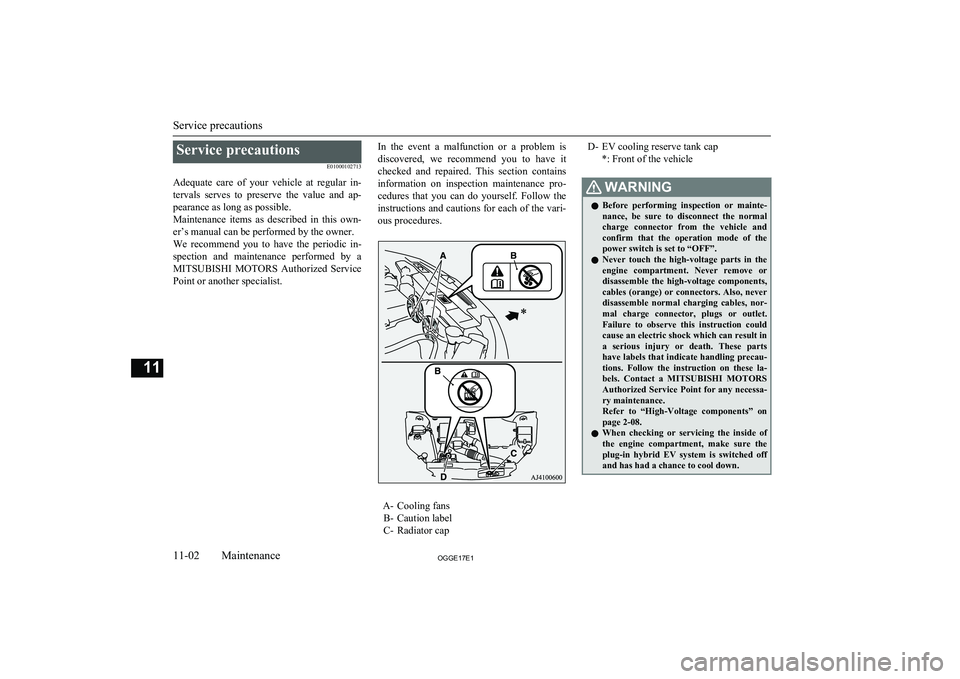
Service precautionsE01000102713
Adequate care of your vehicle at regular in- tervals serves to preserve the value and ap-
pearance as long as possible.
Maintenance items as described in this own- er’s manual can be performed by the owner.We recommend you to have the periodic in-
spection and maintenance performed by a MITSUBISHI MOTORS Authorized Service
Point or another specialist.In the event a malfunction or a problem is discovered, we recommend you to have it
checked and repaired. This section contains information on inspection maintenance pro- cedures that you can do yourself. Follow theinstructions and cautions for each of the vari-
ous procedures.
A- Cooling fans B- Caution label
C- Radiator cap
D- EV cooling reserve tank cap
*: Front of the vehicleWARNINGlBefore performing inspection or mainte-
nance, be sure to disconnect the normal charge connector from the vehicle andconfirm that the operation mode of the power switch is set to “OFF”.
l Never touch the high-voltage parts in the
engine compartment. Never remove or disassemble the high-voltage components,
cables (orange) or connectors. Also, never disassemble normal charging cables, nor-
mal charge connector, plugs or outlet. Failure to observe this instruction could
cause an electric shock which can result in
a serious injury or death. These parts have labels that indicate handling precau-
tions. Follow the instruction on these la- bels. Contact a MITSUBISHI MOTORS
Authorized Service Point for any necessa-
ry maintenance.
Refer to “High-Voltage components” on page 2-08.
l When checking or servicing the inside of
the engine compartment, make sure the
plug-in hybrid EV system is switched off and has had a chance to cool down.
Service precautions
11-02OGGE17E1Maintenance11
Page 464 of 548
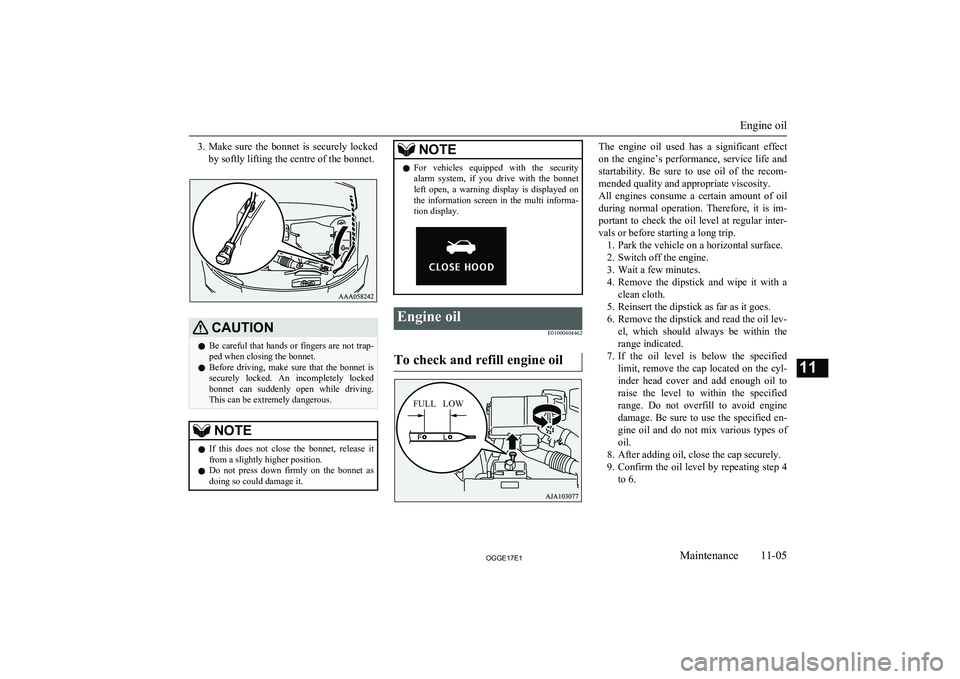
3.Make sure the bonnet is securely locked
by softly lifting the centre of the bonnet.CAUTIONl Be careful that hands or fingers are not trap-
ped when closing the bonnet.
l Before driving, make sure that the bonnet is
securely locked. An incompletely locked bonnet can suddenly open while driving.
This can be extremely dangerous.NOTEl If this does not close the bonnet, release it
from a slightly higher position.
l Do not press down firmly on the bonnet as
doing so could damage it.NOTEl For vehicles equipped with the security
alarm system, if you drive with the bonnetleft open, a warning display is displayed on
the information screen in the multi informa- tion display.Engine oil
E01000404462
To check and refill engine oil
The engine oil used has a significant effecton the engine’s performance, service life and
startability. Be sure to use oil of the recom- mended quality and appropriate viscosity.
All engines consume a certain amount of oil during normal operation. Therefore, it is im-portant to check the oil level at regular inter-
vals or before starting a long trip. 1. Park the vehicle on a horizontal surface.
2. Switch off the engine.
3. Wait a few minutes.
4. Remove the dipstick and wipe it with a
clean cloth.
5. Reinsert the dipstick as far as it goes.
6. Remove the dipstick and read the oil lev- el, which should always be within therange indicated.
7. If the oil level is below the specified
limit, remove the cap located on the cyl- inder head cover and add enough oil to
raise the level to within the specified
range. Do not overfill to avoid engine damage. Be sure to use the specified en-
gine oil and do not mix various types of
oil.
8. After adding oil, close the cap securely.
9. Confirm the oil level by repeating step 4
to 6.
Engine oil
11-05OGGE17E1Maintenance11 FULL LOW
Page 465 of 548
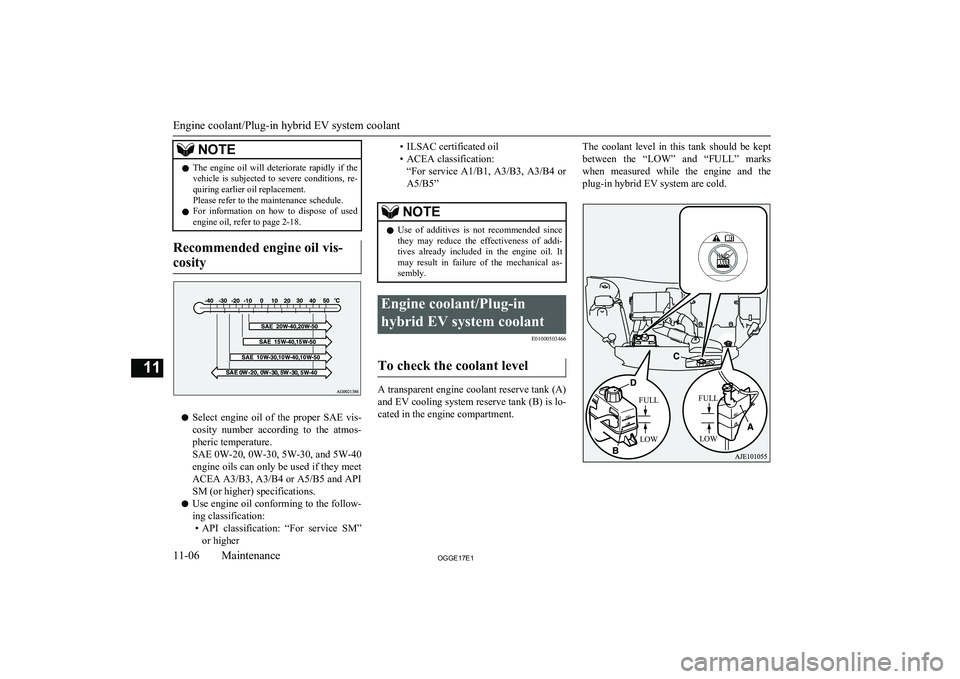
NOTElThe engine oil will deteriorate rapidly if the
vehicle is subjected to severe conditions, re-
quiring earlier oil replacement.
Please refer to the maintenance schedule.
l For information on how to dispose of used
engine oil, refer to page 2-18.
Recommended engine oil vis-
cosity
l Select engine oil of the proper SAE vis-
cosity number according to the atmos-
pheric temperature.
SAE 0W-20, 0W-30, 5W-30, and 5W-40
engine oils can only be used if they meet ACEA A3/B3, A3/B4 or A5/B5 and API
SM (or higher) specifications.
l Use engine oil conforming to the follow-
ing classification: • API classification: “For service SM”
or higher
• ILSAC certificated oil
• ACEA classification: “For service A1/B1, A3/B3 , A3/B4 or
A5/B5”NOTEl Use of additives is not recommended since
they may reduce the effectiveness of addi-
tives already included in the engine oil. It may result in failure of the mechanical as-
sembly.Engine coolant/Plug-in
hybrid EV system coolant E01000503466
To check the coolant level
A transparent engine coolant reserve tank (A)
and EV cooling system reserve tank (B) is lo- cated in the engine compartment.
The coolant level in this tank should be kept
between the “LOW” and “FULL” marks
when measured while the engine and the
plug-in hybrid EV system are cold.
Engine coolant/Plug-in hybrid EV system coolant
11-06OGGE17E1Maintenance11 FULLLOW FULL
LOW
Page 466 of 548

To add coolant
The cooling system is a closed system andnormally the loss of coolant should be very
slight. A noticeable drop in the coolant level
could indicate leakage. If this occurs, we rec- ommend you to have the system checked as
soon as possible.
If the level should drop below the “LOW” level on the reserve tank, open the lid and
add coolant.
Also, if the reserve tank is completely empty, remove the radiator cap (C) or the reservetank cap (D) and add coolant until the level reaches the filler neck.
WARNINGl Do not open the radiator cap (C) and the
reserve tank cap (D) while the engine andthe plug-in hybrid EV system are hot. The
coolant system is under pressure and any hot coolant escaping could cause severe burns.Anti-freeze
The engine coolant and the plug-in hybrid
EV system coolant contains an ethylene gly-col anti-corrosion agent. Some parts of the
engine and the plug-in hybrid EV system are
cast aluminium alloy, and periodic changing of the engine coolant and the plug-in hybridEV system coolant are necessary to prevent
corrosion of these parts.
Use “ MITSUBISHI MOTORS GENUINE
SUPER LONG LIFE COOLANT PREMI-
UM” or equivalent *
.
MITSUBISHI MOTORS GENUINE Coolant
has excellent protection against corrosion and rust formation of all metals including alumi-
nium and can avoid blockages in the radiator,
heater, cylinder head, engine block, etc.
Because of the necessity of this anti-corro- sion agent, the coolant must not be replaced
with plain water even in summer. The re-
quired concentration of anti-freeze differs de- pending on the expected ambient tempera-
ture.
Above -35 °C: 50 % concentration of anti- freeze
* similar high quality ethylene glycol based
non-silicate, non-amine, non-nitrate andnon-borate coolant with long life hybrid
organic acid technologyBelow -35 °C: 60 % concentration of anti-
freezeCAUTIONl Do not use alcohol or methanol anti-freeze
or any engine coolants mixed with alcohol or methanol anti-freeze. The use of an im-
proper anti-freeze can cause corrosion of the aluminium components.
l Do not use water to adjust the concentration
of coolant.
l Concentrations exceeding 60 % will result in
a reduction of both the anti-freeze and cool-
ing performance thus adversely affecting the engine.
l Do not top up with water only.
Water by itself reduces the rust-protective
and anti-freeze qualities of the coolant and has a lower boiling point. It can also causedamage to the cooling system if it should freeze. Do not use tapwater, as it can causecorrosion and rust formation.
During cold weather
If the temperatures in your area drop below
freezing, there is the danger that the coolant
in the engine, plug-in hybrid EV system or radiator could freeze and cause severe dam-age to the engine and/or radiator. Add a suffi-
cient amount of anti-freeze to the coolant to prevent it from freezing.
Engine coolant/Plug-in hybrid EV system coolant
11-07OGGE17E1Maintenance11
Page 468 of 548

Fluid type
Use brake fluid conforming to DOT3 or
DOT4 from a sealed container. The brake fluid is hygroscopic. Too much moisture in
the brake fluid will adversely affect the brake system, reducing the performance.
CAUTIONl Take care in handling brake fluid as it is
harmful to the eyes, may irritate your skin
and also damage painted surfaces.
l Use only the specified brake fluid.
Do not mix or add different brands of brake fluid to prevent chemical reactions.
Do not let any petroleum-based fluid touch, mix with, or get into the brake fluid.
This will damage the seals.
l Keep the reservoir tank cap closed to pre-
vent the brake fluid from deteriorating ex- cept maintenance.
l Clean the filler cap before removing and
close the cap securely after maintenance.Auxiliary battery
E01001203705
The condition of the auxiliary battery is very
important for quick starting of the plug-in hy-
brid EV system and proper functioning of the vehicle’s electrical system. Regular inspec- tion is especially important in cold weather.
Be sure to have a MITSUBISHI MOTORS
Authorized Service Point check the auxiliary battery.WARNINGl Be sure to have a
MITSUBISHI
MOTORS Authorized Service Point
charge the battery. Do not charge the bat- tery yourself. Flammable gases may leak
and explode.CAUTIONl There is a type of auxiliary battery is not
properly installed in the vehicle, even if thesame specification.
When replacing the auxiliary battery, please
contact a MITSUBISHI MOTORS Author-
ized Service Point.NOTEl When the auxiliary battery is removed, the
controlling timer for forcibly starting the en-
gine may be reset.
Since a fuel injection device may cause a clogging if the state where the engine does
not operate continues after reset of the timer,
please press the battery charge switch in or-
der to start the engine. However, when the drive battery is near full charge, even if the
battery charge switch is pressed, the engine
may not start. In that case, press the battery charge switch again after the drive battery
quantity decreases. Refer to “Battery charge
mode switch” on page 7-28.
l When the auxiliary battery is removed, since
the timer control of the MITSUBISHI Re-
mote Control is reset and the drive battery temperature control cannot be used, commu-
nicate the wireless LAN device and your ve-
hicle again.
l When the auxiliary battery is removed, the
timer control of the MITSUBISHI Remote
Control is reset and each function of the MITSUBISHI Remote Control cannot be
used. Also the drive battery cannot be
warmed up.
Communicate the wireless LAN device and your vehicle again.
Auxiliary battery
11-09OGGE17E1Maintenance11
Page 474 of 548

NOTElDo not allow the wiper arm to fall onto the
window glass; it could damage the glass.
4. Firmly insert the retainer (C) into the
groove (D) in the wiper blade.
Refer to the illustration to ensure that the
retainers are correctly aligned as you in-
sert them into the groove.NOTEl If a retainer is not supplied with the new
wiper blade, use the retainer from the old
blade.General maintenance
E01002701556
Fuel, engine coolant, oil and ex- haust gas leakage
Look under the body of your vehicle to check
for fuel, engine coolant, oil and exhaust gas
leaks.
WARNINGl If you see a suspicious fuel leak or if you
smell fuel, do not operate the vehicle; call
your MITSUBISHI MOTORS Author-
ized Service Point for assistance.
Exterior and interior lamp op-
eration
Operate the combination lamp switch to
check that all lamps are functioning properly.
If the lamps do not illuminate, the probable cause is a blown fuse or defective lamp bulb.
Check the fuses first. If there is no blown
fuse, check the lamp bulbs.
For information regarding the inspection and
replacement of the fuses and the bulbs, refer
to “Fuses” on page 11-16 and “Replacement
of lamp bulbs” on page 11-23.
General maintenance
11-15OGGE17E1Maintenance11
Page 475 of 548
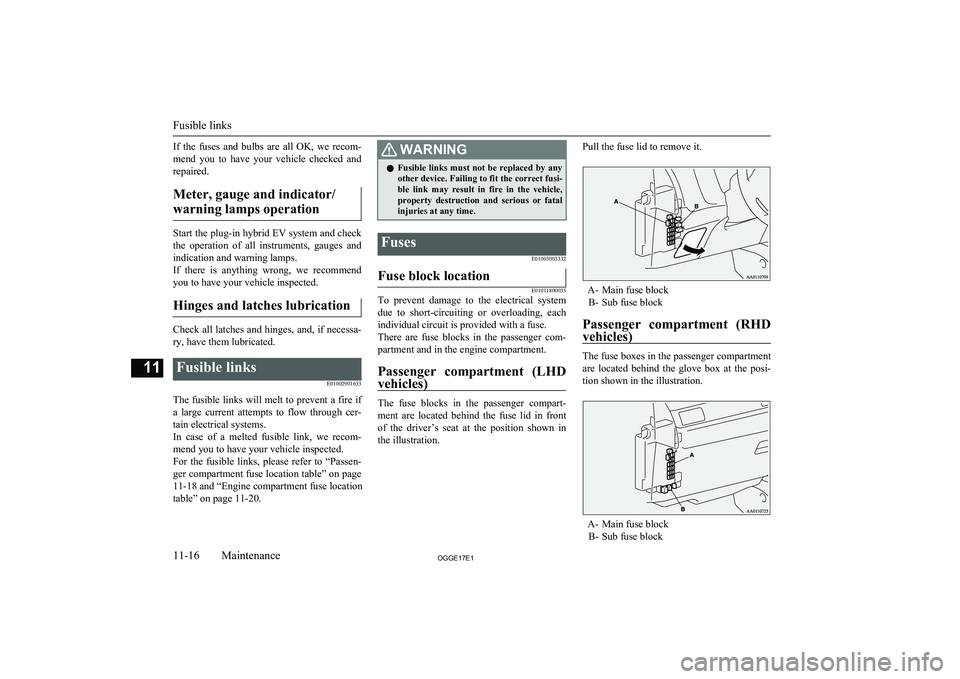
If the fuses and bulbs are all OK, we recom-
mend you to have your vehicle checked and repaired.
Meter, gauge and indicator/warning lamps operation
Start the plug-in hybrid EV system and check
the operation of all instruments, gauges and indication and warning lamps.
If there is anything wrong, we recommend
you to have your vehicle inspected.
Hinges and latches lubrication
Check all latches and hinges, and, if necessa- ry, have them lubricated.
Fusible links
E01002901633
The fusible links will melt to prevent a fire if
a large current attempts to flow through cer- tain electrical systems.
In case of a melted fusible link, we recom- mend you to have your vehicle inspected.For the fusible links, please refer to “Passen-
ger compartment fuse location table” on page
11-18 and “Engine compartment fuse location
table” on page 11-20.
WARNINGl Fusible links must not be replaced by any
other device. Failing to fit the correct fusi-
ble link may result in fire in the vehicle,
property destruction and serious or fatal injuries at any time.Fuses
E01003003332Fuse block location
E01011800035
To prevent damage to the electrical systemdue to short-circuiting or overloading, each individual circuit is provided with a fuse.
There are fuse blocks in the passenger com- partment and in the engine compartment.
Passenger compartment (LHD
vehicles)
The fuse blocks in the passenger compart-
ment are located behind the fuse lid in front of the driver’s seat at the position shown in
the illustration.
Pull the fuse lid to remove it.
A- Main fuse block B- Sub fuse block
Passenger compartment (RHD vehicles)
The fuse boxes in the passenger compartment
are located behind the glove box at the posi- tion shown in the illustration.
A- Main fuse block B- Sub fuse block
Fusible links
11-16OGGE17E1Maintenance11
Page 481 of 548
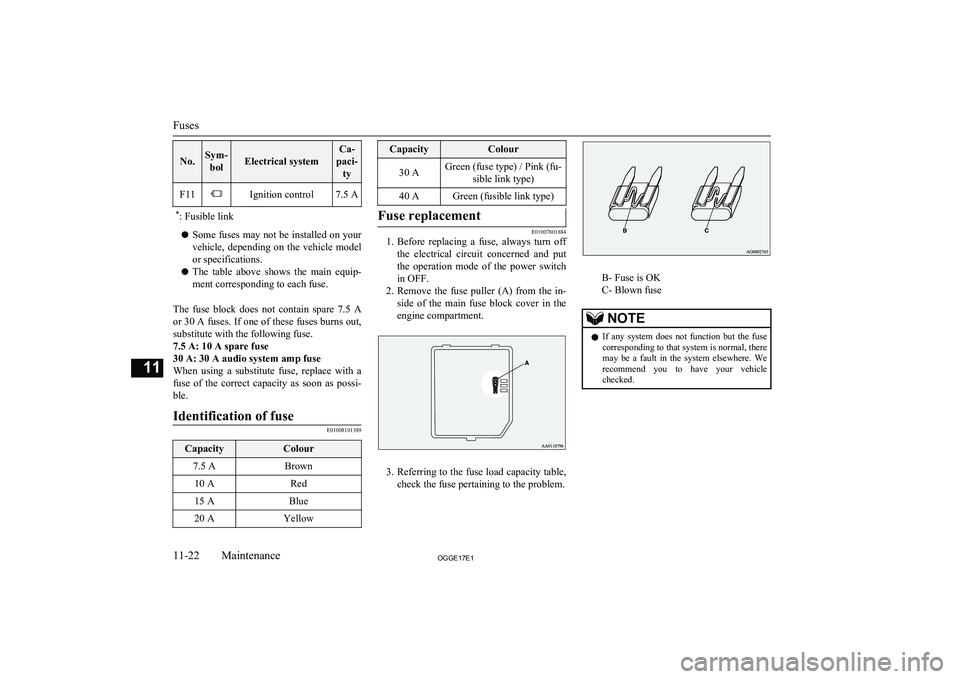
No.Sym-bolElectrical system
Ca-
paci- tyF11Ignition control7.5 A*: Fusible link
l Some fuses may not be installed on your
vehicle, depending on the vehicle model
or specifications.
l The table above shows the main equip-
ment corresponding to each fuse.
The fuse block does not contain spare 7.5 A or 30 A fuses. If one of these fuses burns out,
substitute with the following fuse.
7.5 A: 10 A spare fuse
30 A: 30 A audio system amp fuse
When using a substitute fuse, replace with a fuse of the correct capacity as soon as possi-
ble.
Identification of fuse
E01008101389
CapacityColour7.5 ABrown10 ARed15 ABlue20 AYellowCapacityColour30 AGreen (fuse type) / Pink (fu-
sible link type)40 AGreen (fusible link type)Fuse replacement
E01007801884
1.Before replacing a fuse, always turn off
the electrical circuit concerned and put
the operation mode of the power switch
in OFF.
2. Remove the fuse puller (A) from the in-
side of the main fuse block cover in the
engine compartment.
3. Referring to the fuse load capacity table,
check the fuse pertaining to the problem.
B- Fuse is OK
C- Blown fuse
NOTEl If any system does not function but the fuse
corresponding to that system is normal, theremay be a fault in the system elsewhere. We recommend you to have your vehiclechecked.
Fuses
11-22OGGE17E1Maintenance11
Page 504 of 548

2
220-240 V AC power supplies.......................... 8-764
4-wheel drive operation.....................................7-23A
Accessory (Installation).....................................2-17
Accessory socket............................................... 8-75
Acoustic Vehicle Alerting System (AVAS)......2-06
Active stability control (ASC)...........................7-40
Adaptive Cruise Control System (ACC)........... 7-52
Air conditioner Automatic climate control air conditioner.... 8-04
Important operation tips for the air conditioner................................................... 8-13
Air purifier.........................................................8-13
Airbag................................................................ 5-27 Caution for installing the child re-straint on vehicle with front pas-
senger’s airbag............................................. 5-16
Anti-lock brake system (ABS).......................... 7-37
Ashtray.............................................................. 8-74
Assist grips........................................................ 8-86
Audio CD player...................................................... 8-14
LW/MW/FM radio........................................ 8-14
Troubleshooting............................................ 8-47
Automatic high-beam system............................ 6-56
Auxiliary battery............................................. 11-09
Auxiliary battery charge warning lamp.............6-51
B
Basic knowledge for charging........................... 3-04
Battery charge mode switch.............................. 7-28
Battery save mode switch..................................7-27
Battery Auxiliary battery charge warning lamp........ 6-51
Discharged battery (Emergency starting)..... 9-07
Disposal information for used batteries........ 2-18 Specification............................................... 12-08
Blind Spot Warning (BSW).............................. 7-80
Bluetooth® 2.0 interface................................... 8-50
Bonnet............................................................. 11-04
Bottle holders.................................................... 8-84
Brake assist system............................................7-36
Brake auto hold................................................. 7-32
Brake warning lamp.......................................... 6-50
Brake Anti-lock brake............................................. 7-37
Brake auto hold............................................. 7-32
Braking.......................................................... 7-31
Fluid.................................................. 11-08,12-10
Parking brake................................................ 7-03
Bulb capacity .................................................. 11-24
C
Capacities........................................................ 12-10
Card holder................................................8-74,8-82
Cargo area cover................................................8-85
Cargo loads......................................................7-115
Catalytic converter.......................................... 11-03
Caution for installing the child re- straint on vehicles with front passen-
ger’s airbag...................................................... 5-29
Cautions on handling of 4-wheel drive vehicles................................................... 7-24
Central door locks............................................. 4-16
Charging............................................................ 3-02
Charging indicator............................................. 6-49
Charging system specifications....................... 12-06
Charging troubleshooting guide........................ 3-21
Check engine warning lamp.............................. 6-51
Child restraint.................................................... 5-16 Caution for installing the child re-straint on vehicles with a front
passenger airbag.......................................... 5-16
Caution for installing the child re- straint on vehicles with front pas-
senger’s airbag............................................. 5-29
Child-protection rear doors............................... 4-18
Cigarette lighter................................................. 8-74
Cleaning Exterior of your vehicle.............................. 10-03Interior of your vehicle............................... 10-02
Coat hook.......................................................... 8-86
Combination headlamps and dipper switch...... 6-53
Coolant (engine)....................................11-06,12-10
Coolant (plug-in hybrid EV system)............... 11-06
Cruise control.................................................... 7-42
Cup holder......................................................... 8-83
D
Daytime running lamps
Alphabetical index
13- 1
OGGE17E1Alphabetical index